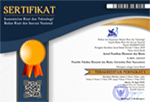The Effect of BI Rate and Exchange Rate on Inflation in Indonesia with the Money Supply as a Mediating Variable
DOI:
https://doi.org/10.33633/jpeb.v7i1.4305Abstract
Inflation can be interpreted as a tendency to increase the prices of goods and services in general and continuously which can be influenced by several factors such as reference interest rates, exchange rates, the money supply and so on. This study intends to analyze about the influence of the BI rate and the exchange rate on inflation in Indonesia with the money supply as an intervening variable. The population in this study is Inflation, BI Rate, Rupiah / USD Exchange Rate, and Money Supply. The sample used is this data in the 2010-2019 period which was analyzed using WarpPLS and Sobel Test. The results show that the BI rate, exchange rate and the money supply have a significant effect on inflation and the money supply can mediate the effect of the BI rate and the exchange rate on inflation which has been proven by the sobel test. Keywords:InflationBI RateExchange RateMoneySupplyReferences
Afrizal, A. 2017. Analisis Kausalitas Inflasi dan Jumlah Uang Beredar di Indonesia Periode Tahun 2000.1 -2014.4. Jurnal Ekonomi Bisnis dan Kewirausahaan (JEBIK), 6(3), 236-250.
Agusmianata, N., Militina, T., & Lestari, D. 2018. Pengaruh jumlah uang beredar dan tingkat suku bunga serta pengeluaran pemerintah terhadap inflasi di Indonesia. In Forum ekonomi (Vol. 19, No. 2, pp. 188-200).
Akinbobola, T.O., et.al. 2012. The Dynamics of Money Supply, Exchange Rate and Inflation in Nigeria. Vol.2, No.4.
Bawa, Sani dkk. 2016. Threshold Effect of Inflation On Economic Growth in Nigeria. CBN. Journal of applied statistic. Vol 3 Iss 1, Hal. 43-63
BPS Indonesia. 2019. Indonesia dalam Angka Tahun 2019.
Bank Indonesia. 2019. Statistik Ekonomi dan Keuangan Indonesia.
Bank Indonesia. 2019. Tinjauan Kebijakan Moneter .Ekonomi, Moneter dan Keuangan
Ebiringa, O. T. and Anyaogu, N. B. 2014. Exchange rate, inflation and interest rates relationships: An autoregressive distributed lag analysis, Journal of Economics and Development Studies, 2(2): 263-279.
Firmansyah.2016. Inflasi, Nilai Tukar Rupiah, Ekspor dan Impor yang Mempengaruhi Terhadap Jumlah Uang Beredar. Jurnal Wira Ekonomi Mikroskil, Volume 6, Nomor 1, April
Fuziah, F. 2015. Kebijakan Moneter Dalam Mengatasi Inflasi Di Indonesia. Signifikan Vol. 4 No. 1 April 2015, 1-93.
Kogid Mori, dan Asid, Rozilee. 2012. The Effect Of Exchange Rates on Economic Growth: Emperical Testing On Nominal Versus Real
Krisnaldy. 2017. Pengaruh Jumlah Uang Beredar, Produk Domestik Bruto, Kurs dan Tingkat Bunga terhadap Inflasi di Indonesia Pendekatan Error Corection Model. Jurnal Kreatif. Vol. 5, No. 1, hal. 132-140
Mahendra. 2016. Analysis of the effect of money demand, interest rates (SBI) and the exchange rate on inflation in Indonesia. JRAK - Vol. 2 No. 1, March 2016 ISSN: 2443 – 1079.
Miles, D. 2014. Inflation, Employment, and Monetary Policy: Objectives and Outcomes in the UK. Journal of Money, Credit and Banking, Supplement to Vol. 46, No. 2 (October 2014), 1-167.
Mohhamed, N., & Gbadebo, A. D. 2015. Monetary Policy and Inflation Control in Nigeria. Vol.6, No.8, 2015, 1-115.
Sari, M. R., & Yeniwati, Y. 2019. Analisis Mekanisme Transmisi Kebijakan Moneter Terhadap Inflasi. Jurnal Kajian Ekonomi dan Pembangunan, 1(2), 309-320.
Setiartiti, L. & Hapsari, Y. 2019. Determinants of Inflation Rate In Indonesia. Jurnal Ekonomi & Studi Pembangunan, 20(1), 112-123
Solhikhin, M. Y. 2016. Pengaruh Kebijakan Moneter Terhadap Inflasi Dan Produk Domestik Bruto. Pengaruh Suku Bunga Terhadap Inflasi, 1-7
Turna, Y., & Özcan, A. 2021. The relationship between foreign exchange rate, interest rate and inflation in Turkey: ARDL approach. Journal of Ekonomi, 3(1), 19-23.
Wahyuni, S. 2016. Analisis Pengaruh Suku Bunga Acuan, Jumlah Uang Beredar, Nilai Tukar, Dan Harga Minyak Dunia Terhadap Laju Inflasi Di Indonesia . Jurnal Ilmu Ekonomi, 1-80
Yodiatmaja, B.2012. Hubungan antara BI rate dan Inflasi pendekatan kausalitas Toda-Yamamoto. Journal of Economics and Policy Jejak, 5(2), 117-229.
Downloads
Published
How to Cite
Issue
Section
License
The copyright of the received article shall be assigned to the journal as the publisher of the journal. The intended copyright includes the right to publish the article in various forms (including reprints). The journal maintains the publishing rights to the published articles.
This work is licensed under a Creative Commons Attribution 4.0 International License.


.png)









